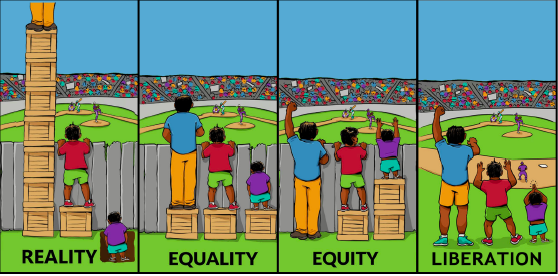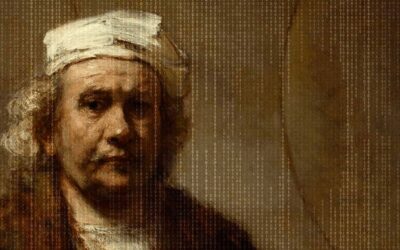Applying the Liberation Model to Museum Grant Funding Inequity

Rachael Cristine Woody
Inequity in grant funding is a topic I’ve written and spoken about throughout 2021. This focus began in 2020, when it became clear the world would not go back to normal after two weeks and the funding relief needed was out of reach for so many of our museums.
That’s why Lucidea and I partnered to create the Grants Directory and Workbook, a free resource to help support museums through the funding application process. This resource is an example of my proposed equity-solution for the field: more centralized and free resources museums can easily access and use. In this post we’re going to dive deeper into grant funding inequity and what the “liberation model” could look like.
The Equity vs Equality Model
Since the formalization of the Diversity, Equity, Accessibility, and Inclusion initiative, a popular drawing has made the rounds to help describe the difference between equity and equality. This art concept has helped many grasp what real equity looks like, and as our understanding has improved, the model has evolved. We’re no longer evaluating equity versus equality—we’re now acknowledging the contextual reality that can further hamper those who are disadvantaged. The evolution of this model has made it clear that it’s not just a lack of equity we need to solve. It’s the very systems and the barriers therein that we need to remove.
Reality, Equality, Equity, and Liberation
Let’s get into an example and review the illustration with two new components: reality and liberation.
Reality: The reality is that many museums are in the literal hole (via the picture). They’re located in small communities, have modest budgets, manage under-represented collections, and/or don’t regularly receive government subsidized funding. These museums are in the hole compared to their tall neighbor who stands on 7 boxes. These boxes in our example contain privilege in the form of: endowments, relationships with multi-million-dollar donors, a Development department, and/or social capital that can be converted into economic gain. These privileges are only typically available to large and well-off museums with famous, western-centric collections located in populous and affluent areas.
Equality: Equality in this example is merely the promise that all museums have equal access to grant relief funding, but it does nothing to account for unequal resources. While our short person in the picture has access to 1 box just like their two neighbors, they still cannot see over the fence. Supplying equal access via application for funding is not enough to help the majority of smaller museums to achieve their goal—they still cannot see over the fence.
Equity: Equity requires increased access to funds as well as increased access to resources that can help museums successfully achieve relief funding in the amount they need. In an equity scenario, the short person has an extra 2 boxes compared to their tall neighbor. This approach evens the playing field by granting certain advantages to those who are disadvantaged. As a result, everyone can see over the fence.
Liberation: But here’s the thing. I found myself struggling with how to solve this equity access issue because the problem is the funding system itself. What is actually needed is an overhaul of the system. It’s time to consider what liberation can look like if we were to remove the access to funding issue by providing adequate funding to everyone. To use our current example of museums needing to access relief funding, I propose that instead of requiring a grant application process to fight over a woefully inadequate amount of funds, we should instead automatically grant museums a set amount of money. I’m proposing that we give museums relief in the form of their own universal income via stimulus checks. No complicated, time consuming application needed.

© Interaction Institute for Social Change | Artist: Angus Maguire. Based on an original concept by Craig Froehle. Used with permission.
Conclusion
In this time of extreme hardship, we need to dispense with the antiquated and inherently inequitable grant funding system forcing museums to compete against each other for federal funds. Instead, we need to lobby for increased funding and evolve into a liberated form of financially shoring up museums through easily granted financial awards.

Rachael Cristine Woody
Expert Rachael Cristine Woody advises on museum strategies, collections management, and grant writing for a wide variety of clients. In addition to several titles published by Lucidea Press, Ms. Woody is a regular contributor to the Think Clearly blog and a popular presenter.
Similar Posts
No-Code Digital Storytelling Example: Rembrandt’s Self-Portrait at Kenwood House
Explore how English Heritage’s Kenwood House uses the no-code platform Shorthand to bring Rembrandt’s Self-Portrait with Two Circles to life through visual storytelling and interactive design.
Exploring No-Code Digital Storytelling: Hoover’s “Fanning the Flames” Exhibit
Explore no-code digital storytelling with Hoover’s ‘Fanning the Flames’ exhibit. See how interactive tools (Deep Zoom Color Compare & Hot Spot) enhance user engagement and the visual experience.
An Introduction to Scrollytelling for Museums
Discover how museums use scrollytelling and digital storytelling platforms to create immersive narratives. This introduction explores key concepts and approaches to interactive storytelling.
Exploring Self-Determinate Multiple Pathways: An Example of Digital Storytelling
Discover how self-determinate multiple pathways offer flexible interactive storytelling in museum exhibits. Learn from the Tenement Museum’s ‘Your Story Our Story.’






Leave a Comment
Comments are reviewed and must adhere to our comments policy.
0 Comments